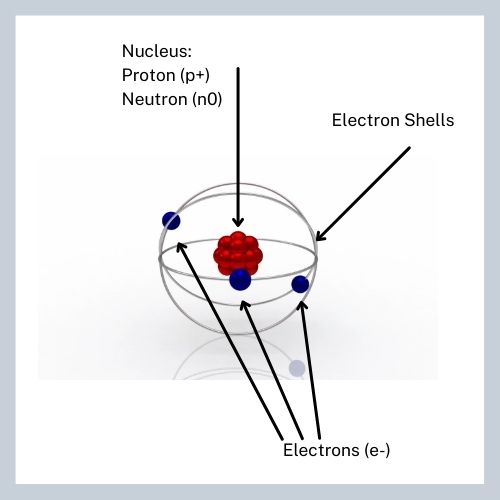
When using electrical treatments with clients, it’s important to know the difference between the currents and frequencies used. While qualified therapists will know the science behind the treatments. Clients sometimes want to be pointed somewhere to find out a little more in-depth into how and why it works. We’ve created this post which you can share with your clients who are a little more curious about the science.
Electrical Properties – Atoms
Structure of an atom:
An atom is the building block of all matter, whether that is solid, liquid or even gas.

Atoms are made up of three particles:
- Protons p+ (positive charge)
- Neutrons n0 (no charge)
- Electrons e– (negative charge & orbit around the nucleus)
Electrons can:
Be added to the atom, or lost from the atom, which causes the atoms to become particles with an electrical charge. These are called IONS.
ION Properties;
- Atoms with NO electrical charge. Same number of protons and electrons.
- ANION – Atom gains an electron, and causes the atom to take on a negative charge (negative ion).
- CATION – Atom loses an electron, which means there are more protons than electrons, so the atom becomes a positive ion.
Ions can also interact with each other;
- Ions of the same charge are repelled by each other.
- Ions of different charges attract each other.
Water and Ions;
- When an electrical current passes through water containing ions, the ions then move.
- Anions (-) are attracted to the positive electrode called the anode.
- Cations (+) are attracted to the negative electrode called the cathode.
Electrical Current
When an electrical current flows through a metal wire, electrons flow from atom to atom through the metal.
The flow of electrons through the wire between the electrical supply and the electrical machine/appliance, is called an ELECTRICAL CURRENT.
Measurement
AMPS (A)
Volts / Mains Supply is 240 Volts in UK.
(W and KW)
Ohms (Ω)
Hertz (Hz)
Electrical State
Rate of Flow of Electric Current
Pressure causing the current to flow around the electrical circuit.
Electrical resistance needed to transfer the electrical energy. Resistance is reduced via a conductor of electricity
Mains electricity is alternating current (AC). It moves back and forth. Alternates 5 times per second. Known as a frequency of 50 cycles per second.
Conductors
Materials which are good conductors of electricity. Examples are;
- The Human Body (contains conducting properties).
- Water.
- Saline Solutions.
- Metals.
Insulators
Insulators don’t conduct electricity well (does not flow) and inhibit or break the circuit. Examples are;
- Rubber.
- Plastic.
- Polystyrene.
- Oil.
- Wood.
- Plastic.
Fuse
Helps to protect the appliance/gadget from too much current. The wire in the fuse will melt, and breaks the current. You may have seen this in the plugs you have at home for your own electrical appliances, often 3 Amp, 5 Amp or 13 Amp fuses, which melt and prevent damage to your gadget/appliance if there is an electrical surge in the current.
Transformer
Reduces the voltage of the mains supply.
Rectifier
Changes current from A.C to D.C.
Capacitor
Regulates irregularities in the constant stream of electrons to help prevent a surge.